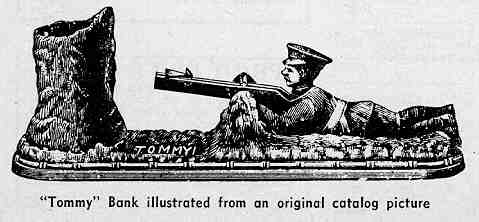Mechanical Banks — English vs. American
by F.H. Griffith - HOBBIES Magazine - May, 1957

English mechanical banks, among certain of the collectors, have never attained the desirability or popularity of the American made variety. It is understandable that they might not be quite as desirable as those made in the United States as after all mechanical banks are definitely Americana and definitely an original toy product of our country. However, this does not lessen the importance of the English mechanical banks as a collector’s item in the field of mechanical bank collecting.
Perhaps some of the so-called mystery surrounding the English banks has indirectly caused certain of the collectors to feel that they are not as desirable in a collection. Actually the English banks, for the most part, were made by companies that were comparable to the concerns who manufactured banks in our own country, and these English banks definitely represent an important group of the mechanical banks. While a number of different specimens were made in England it seemed that the bust type of mechanical bank was the most popular, and in this group they excelled in the number of different types and subjects.
There were two outstanding English concerns that made mechanical banks, John Harper & Company Ltd. and Chamberlin & Hill Ltd. Harper’s banks were often identified with the name "Beatrice" as a trade name. They made one of the earliest of the English mechanicals, the Wimbledon Bank, in 1885. Among the other fine specimens manufactured by Harper are such banks as Dinah, the rare Kiltie, Jolly Nigger Butterfly Tie, Little Joe, Hoop-la Bank, Football Bank, and Jolly Nigger Top Hat. They also made the Tommy Bank, and to the best of the writer’s knowledge, no example of this has been found as yet. The Grenadier Bank, similar to our Creedmore, was also made by Harper in the 1898 period. Chamberlin & Hill made, among other mechanical banks, the rare Clown Money Box or Clown Bust. So far the writer knows of only one specimen of this bank in a collection. Then they made a different type Jolly Nigger with both movable and fixed eyes. The outstanding bank produced by them, however, was the Little Moe Bank in which the bust type figure tips his hat in polite thanks upon receiving the coin. All the mechanical banks made by John Harper & Chamberlin & Hill are cast iron and appropriately painted in various colors.
The Jolly Nigger Moves Ears is another interesting mechanical bank produced in England. This was made in aluminum and the designers and patentees of this bank were Robert Eastwood Starkie and Nellie Starkie of Burnley, England. This bank is not to be confused with the recently made model designed by Robert Patterson Starkie. The copyright and the Register of Design on this bank were taken out in August, 1945. In this recent model the ears fit on a line with the front and back half, also the overall casting is different than the original Starkie’s Patent. On the waffle type base plate of the recent model appears the Registration Number 844290. In the original Starkie Patent the name Starkie appears on the back of the bank between the shoulder blades. Also the ears are set forward near the eyes. A V-shaped section on each side of the back half fits into corresponding sections in the front half and it is at this point that the ears are located. This earlier type also has a top hat.
Another very interesting bank of English origin is the John Bull Money Box. This bank is similar to the Hoop-la and the American made Trick Dog. In this case there is no hoop and the dog jumps in front of a figure of John Bull depositing the coin in a barrel. So far the writer has been unable to ascertain the designer or manufacturer of this bank. Here again the writer knows of only one specimen of this bank in a collection.
In any event, to sum up, the writer does not expect that any of the English mechanical banks will ever reach the high pedestal of the Freedman’s or the Harlequin or a number of the other American banks, however, they are an important group and have as much place in a collection as any of the other mechanical banks. No large collection could be considered as completely representative if it did not contain some specimens of the English mechanical banks.
